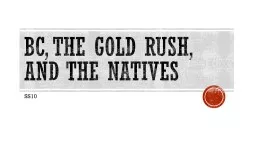

SS10 The Gold Rush Begins Before 1858 British Columbias population white population was tiny only about 800 living on Vancouver Island and just around 100 living on the mainland ID: 579896
Download Presentation The PPT/PDF document "Bc , the Gold Rush, and the Natives" is the property of its rightful owner. Permission is granted to download and print the materials on this web site for personal, non-commercial use only, and to display it on your personal computer provided you do not modify the materials and that you retain all copyright notices contained in the materials. By downloading content from our website, you accept the terms of this agreement.
Slide1
Bc, the Gold Rush, and the Natives
SS10Slide2
The Gold Rush Begins
Before 1858, British Columbia’s population
white
population was tiny; only about 800 living on
Vancouver Island
and just around
100
living on the
mainland
But around then,
gold
was discovered in the banks of the
Thompson
River, a branch of the
Fraser
River
This news reached
California,
where many American
prospectors
decided to move north to try and become rich
Over the next year, the mainland population of British Columbia
skyrocketed
by over 10,000, mostly consisting of
Americans
trying to find gold on the Fraser RiverSlide3
Fantasy Versus Reality
The gold rush was based on the
fantasy
that anyone could get
rich
quick
People believed that you could simply walk along rivers and find huge
gold nuggets
just lying in wait on the
riverbanks
In reality, the process was much more
difficult;
a
prospector
had to
stake a claim
along a river, dig a
mineshaft
through thick
bedrock
to potentially reach gold
Many miners
died
on their journeys, most never returned to their
homes,
and the vast majority of them did not become
wealthy
Most prospectors ended up working as
labourers
and
miners
for people who staked the first claimsSlide4
Boom and Bust
To serve the rapidly
increasing
population of British Columbia, many new
boomtowns
would be formed near mining areas
The most famous of these was
Barkerville
in central British Columbia, founded by named after a prospector who had struck
gold
in the area
It was initially just a small town with a few cabins and tents, but soon had a population of about
5000
For a time, it was a largest city north of
San Francisco
and west of
Chicago
However, as soon as the gold rush began to fade, its population quickly
fell,
and it was a
ghost town
by the 1900s
These kinds of cities that quickly faded away were common in gold rush regionsSlide5Slide6
The Mainland Joins the EMpire
Because many
miners
ended up staying in British Columbia, the area now had a large
American
population
James Douglas,
governor of Vancouver Island, was worried that this could lead to America
annexing the regionHe reached out to the British, who responded by turning the region into the
Colony of British Columbia, an official crown colony
They also sent
soldiers
under the command of
Richard Moody
to help build roads and
survey
the regionSlide7Slide8
The Natives of British Columbia
Before to the gold rush, BC’s
first nations
were the
largest
group of people in the region
They often held an
advantageous
position; they would
trade
with prospectors and acted as
guides
for people travelling to the
goldfields
But in the 1860s, BC built a
road
from
Barkerville
to
Yale
to make sure that gold would leave the region by the Fraser River
This
removed
the need for natives to act as guides for people travelling north to mines
Furthermore, many American and European miners would disturb their
salmon weirs,
disrupting the salmon harvest for nativesSlide9
A modern Salmon WeirSlide10
Death Comes to Call
In 1862, a
smallpox
epidemic struck
Victoria.
While everyone was affected, it was
worst
for BC’s
First Nations
Why do you think a disease like smallpox would be especially harsh for First Nations?
Because they had not been
exposed
to it before, smallpox was almost always
fatal
for BC’s natives
In response, authorities
destroyed
the homes of Natives living near Victoria and forced them to
leave
the area
They then would travel further north,
infecting
other Native peoples, causing entire
villages
to die away
Vancouver Island had an estimated population of about 60,000 natives prior to the
outbreak,
and over
half
of them diedSlide11
The Epidemic
The epidemic was made even worse by European
traders,
who would
steal
blankets and other goods from
dead
Natives and sell these to other Native communities
This caused smallpox to spread to BC’s
mainland,
where it continued to affect the natives living there
This caused even more deaths; even more Natives died of the
disease
on the mainland than on Vancouver Island
This drove some natives to
rebellion;
in 1864, a group of
Chilcotin
smallpox survivors
attacked railway workers, killing fourteen of them
Five
Chilcotin
were arrested and
executed
for their role in the attack